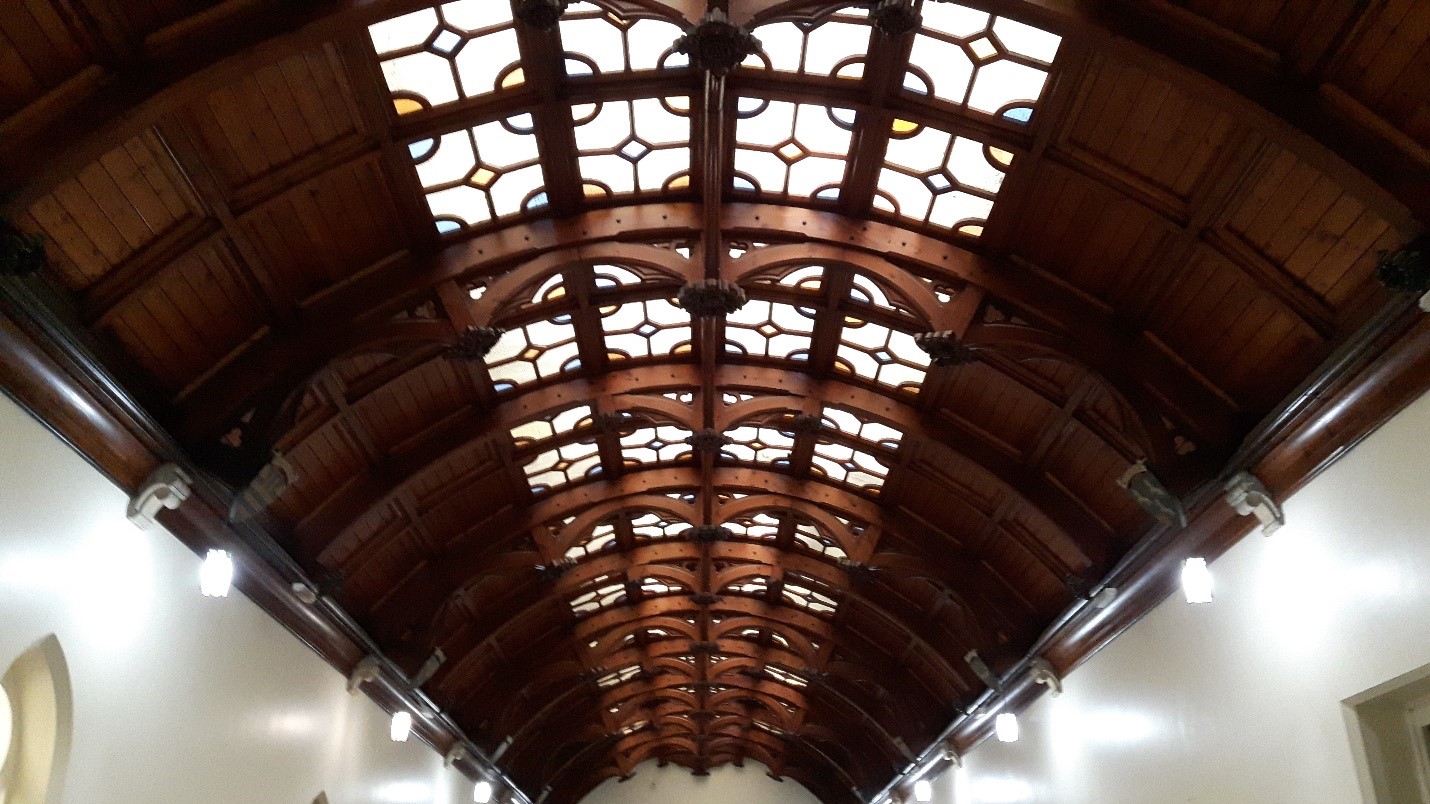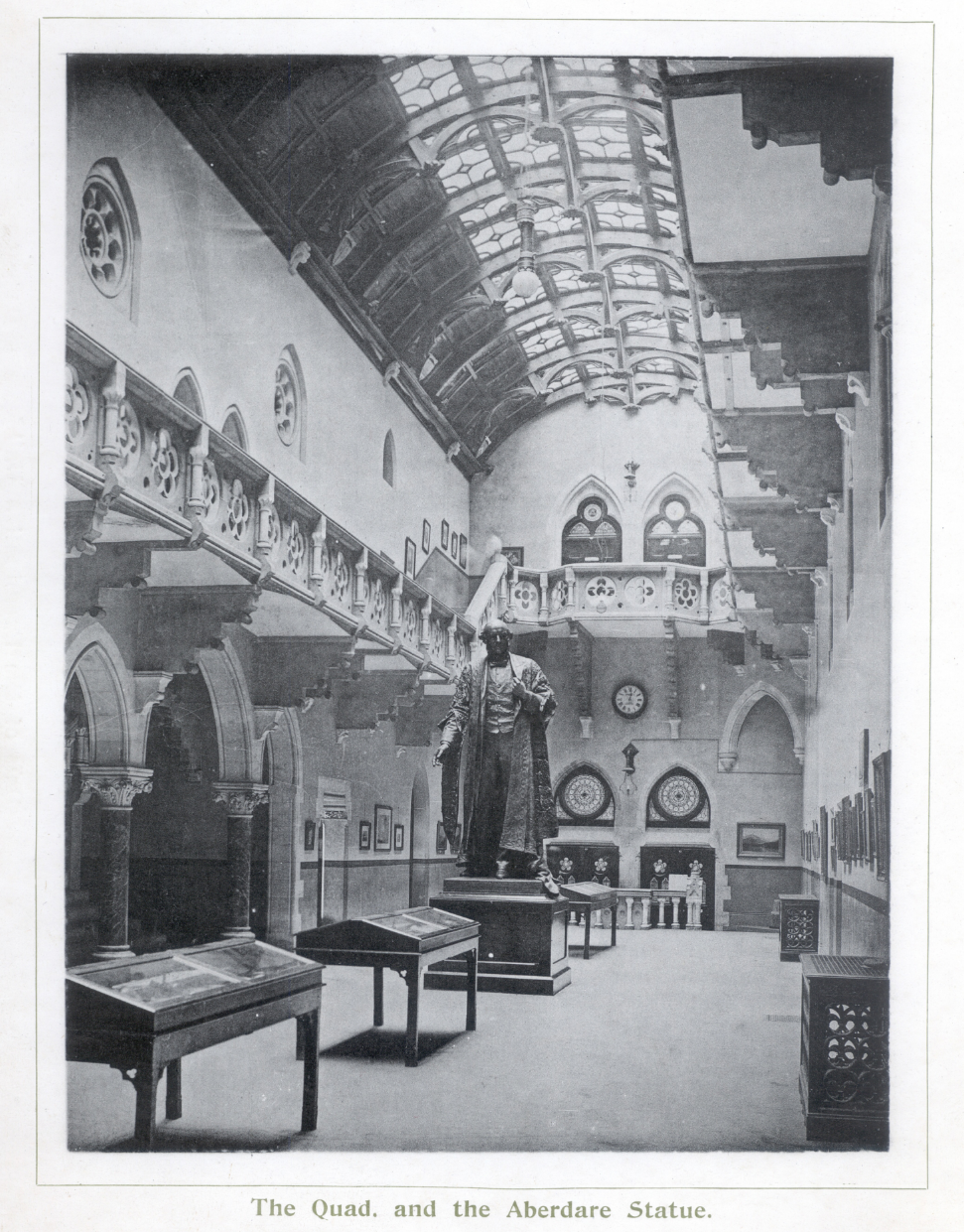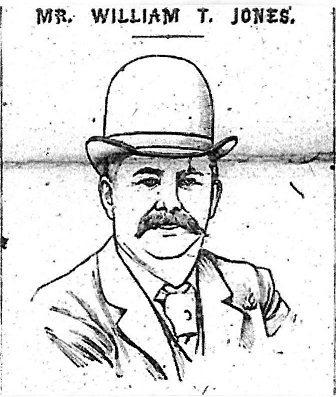W.T. Jones and the development of the Old College Quad
For nearly a hundred years the Old College Quad was the centre of social life for Aberystwyth students, and as Dr E.L. Ellis wrote in his book The University College of Wales Aberystwyth 1872-1972:
The Quad (and its surrounding balcony) was a place to see and be seen, and, over the years, it made every bit as important a contribution to the education of Aberystwyth students as any lecture-room or laboratory.

But how did this amazing open space, with its wonderful ornate roof, come about? Here is E.L. Ellis again:
In 1889-90 there was a relatively small structural alteration to the College building that was to have a profound significance. W.T. Jones of Melbourne, Australia, provided enough money for an ornamental inner roof to be built on the ‘College corridor’, so called. Thus the indoor ‘Quad’ came into existence, and from that time onwards, certainly until the 1950s, it became the great focus of student life. At first movement was regulated strictly, women on one side, men on the other, separated for a time by a ‘mid-wall of partition’, a long line of museum cases. Here daily, between lectures, an elaborate separate crocodile perambulation of men and women circulated, and all sorts of tricks and stratagems had to be learned in order to circumvent the official near-segregation of the sexes.

This ‘relatively small structural alteration’ was brought about by the rebuilding work that followed the fire of July 1885. That near disastrous fire:
destroyed the whole of the northern portion of the College, including all the rooms used as lecture-rooms, laboratories, library, museum, and students’ private rooms. The south portion of the building was fitted up for Science Classes, and the Principal’s house [the old Castle House which was still at the centre of the building] was utilised as Library and Office, while the Queens Hotel was rented for the Arts Classes. This arrangement continued for three Sessions. After full consultation, it was decided to rebuild the College on the old site, and [John Pollard Seddon] the architect of the original building drew up plans for its reconstruction, in which, by utilisation of space which had been practically wasted for College purposes, far more commodious and convenient premises were secured than had been possible before. About £25,000 were spent on the rebuilding(University College of Wales, Students’ Handbook 1903).
W.T. Jones’s gift towards the rebuilding work that Ellis mentions was reported in the 31 October 1889 issue of UCW Magazine:
Mr W.T. Jones, who was present at the Soiree on last St. David’s day, has given further proof of his generosity by offering to roof the quadrangle or central hall at the cost of £500. Our sincerest gratitude is due to Mr Jones for a timely and munificent gift.
And in his report to the College Governors at their meeting on Wednesday 15 October 1890, Principal Thomas Charles Edwards expanded on this topic with obvious delight and pride:
A more agreeable duty is to acknowledge most cordially our debt of gratitude to benefactors of the College. Foremost among them this year stands Mr W.T. Jones of Melbourne who presented to the museum a very valuable collection of Australian minerals which has now been arranged and displayed in proper order. But we are even more indebted to Mr Jones for his munificence in defraying the cost of an ornamental inner roof for the central hall of the College. The beautiful design of Mr Seddon was accepted by the Building Committee and the roof constructed by Messrs Davies and Sons of Newtown, who have now finished the work. I am informed by competent judges that no better piece of woodwork is to be seen in any part of the building. The coat of arms of all the Welsh County Councils are arranged along both sides of the hall under the roof. I trust the Council will decide to erect in the central hall, a suitable tablet and inscription commemorating Mr Jones's generous gift (The Cambrian News and Merionethshire Standard, 17 October 1890).
But behind the scenes things had not been as straightforward or cordial as these reports might suggest. John Pollard Seddon’s plan to rebuild the Old College Building following the fire had not been the College authorities’ original choice, but the prohibitive costs of their intention to build a new building on a new site forced them to accept Seddon’s plans. But they remained wary of him and his perceived profligacy.
In 1886 John Ffoulkes Roberts, a Machynlleth-born Manchester businessman, a college vice-president who had taken a particular interest in college building matters, had pressed Principal Edwards to make sure that Seddon’s plans ‘will be fully matured before the contracts are taken so as to avoid alterations out of which Mr Seddon will get a good deal of pickings’. (T.I. Ellis, Thomas Charles Edwards Letters). Roger Webster thought that ‘this was a grossly unjust comment’ and that it was Seddon’s enthusiasm for his art that sometimes led to his overspending (J. Roger Webster, Old College Aberystwyth).
But Roberts was not the only member of the College Council who had reservations over Seddon and had decided to keep an eye on him. On 23 November 1889 Roberts wrote to Principal Edwards saying that the Building Committee had requested that Seddon write a report on ‘the new project of doing the ceiling & Mr Jones of Melbourne is to be invited to meet the Sub Committee’. It’s possible that Roberts’s reservation over Seddon was somehow conveyed to W.T. Jones, as in another letter to Thomas Charles Edwards in January 1890 he writes:
you say that Mr Jones of Melbourne emphatically has stated that he would not give a penny if Seddon is employed. Now this should be carried out at all costs. Seddon should not be employed, only to purchase the plans from him. We have managed to keep the dish even so far with Seddon and if possible let us do all in our power not to quarrel over the Building – nevertheless I do not see how Seddon can be employed if you are to keep right with the donor & that must be done. This effectively brought an end to John Pollard Seddon’s connection with the College. He was paid £25 for his plans, and in March 1890 the building firm of Davies and Sons, Newtown, was awarded the contract to build the roof for £417.
But who was this Mr W.T. Jones, Melbourne, whose generosity paid for the ornamental inner roof of the Quad and was so against Seddon completing his rebuilding work?

From the 26 August 1890 edition of the Sporting Standard which contained a brief profile of W.T. Jones as a racehorse owner.
In his first ‘Letter from Melbourne’ that appeared in the Aberystwyth Observer and Ceredigion County Times on 22 January 1887, An Aberystwythian says that he intends to write about the
successes of several Cardiganshire men in these colonies and that not the least notable among them is an Aberystwyth man named Mr W. T. Jones, who is one of the leading members of the Melbourne Stock Exchange and that some of the boys who were in John Evans' school in Chalybeate Terrace, corner of Lewis Terrace, [Alexandra Road today], about 33 or 34 years ago, may remember him.
And after digressing to talk about John Evans’ school, An Aberystwythian returns to W.T. Jones.
There is no mistaking Mr Jones as a Welshman, for it’s quite common for him when meeting a fellow-countryman, whether rich or poor, or whether in the street or in the place "where merchants most do congregate," to hear him blurt out an enquiry in Welsh as to how they are getting on. On ’Change [the Melbourne Stock Exchange] he is known as the "warm-hearted Welshman," and if any charitable subscription is to be initiated he is always first in the field as a leader. Many are they who have been relieved by his generosity, and the only fault I have ever heard people find with him is that he is not more discreet in his giving; but I suppose he goes on the principle that it is better that nine rogues should be relieved indiscriminately than one deserving, honest man should be passed by unrelieved. As a speculator on the Stock Exchange he is without a second, and when he takes the run of the market in any stock people watch the course of events as if a Jay Gould or a Vanderbilt had been taking a plunge. There are some large businesses of the same character as Mr Jones' in Melbourne, but I have been told that he does one of – if not the – Iargest Stock Brokering businesses in Australia, and that his transactions during the year exceed a million (£1,000,000). Rather a jump from John Evans' school, and the old man little dreamt that when he was drilling “practice” in 1851-1852 into the boy Jones he was qualifying him to be one of the magnates of the Stock Exchange of Melbourne. There is a talk on ’Change that he is going to take a trip home next year, accompanied by his wife and family. I don't know if it is true, but time will tell.
It appears that W.T. Jones did return home, and if not in 1888 then certainly in 1889, as it was in that year that he attended the St David’s Day Soiree at Old College where he pledged £500 for the Quad roof. And he was still in Britain later the same year when his interest in horseracing bore fruit, when on 5 November 1889 in his absence his horse, Bravo, won the Melbourne Cup, as recorded in a tribute that was paid to him after his death on 20 November 1911:
The death occurred in London yesterday of Mr W. T. Jones, the well-known race-horse owner, who in 1889 won the Melbourne Cup with Bravo. Mr. W. T. Jones was a wealthy mining speculator who had lived in England for some years. He was there when his horse won the Melbourne Cup, but subsequently returned to Australia (The Advertiser, Adelaide. 21 November 1911).
And in 1896, Newhaven, a horse joint owned by him also won the Melbourne Cup. But these were not his only horses. At a sale of racehorses held at the Newmarket stables, Randwick, Sydney, in April 1890, after he had returned to Australia, W.T. Jones bought three other horses, Sinecure, Dreadnaught and Litigant, for a total of 4,950 guineas. And after he returned to Britain his interest in horseracing continued:
The late Mr. W.T. Jones had his share of luck as a horse owner in England. He won a 'classic' event – the Oaks of 1898 – with Airs and Graces. Last month Mr. Jones was successful with Willaura, who on November 10 finished second in the Liverpool Autumn Handicap (Daily Advertiser, Wagga Wagga. Wednesday 22 November 1911).
Willaura had also ‘been specially kept for the November Handicap Plate at Warwick this week, and after his bold bid for the Liverpool Cup was generally expected to win it’.But following W.T. Jones’s death, ‘the nomination, however, became void’ (Cambrian News. Friday 24 November 1911).
W.T. Jones was obviously a much respected racehorse owner because in March 1902 he was alongside the Duke of Devonshire when he gave evidence to the House of Lords Committee on betting. The Barrier Miner was only one of many Australian newspapers that reported his appearance and quoted a portion of his evidence:
William T. Jones, of Victoria, a former Melbourne Cup winner, was also examined. He said that there was far more betting in Australia than in England. It was equally possible to stop a river flowing as to stop betting in Australia.
But how had this Aberystwyth boy who needed ‘drilling practice’ with his tables at school become a leading member of the Melbourne Stock Exchange and a serious racehorse owner?
Very little has been written about W.T. Jones, and what follows is what I’ve gleaned from reports that appeared in Aberystwyth and Australian newspapers during his lifetime, and from the many tributes that appeared after his death. Not surprisingly it’s in the Aberystwyth papers that one learns about his early life.
William Thomas Jones:
was born at Aberystwyth, being the son of the late Mr. John Jones, who carried on the business of draper at the premises now occupied by Mr. R. Saycell, fishmonger, Great Darkgate-street. He was a brother to the late Mrs Thomas Thomas, [Llysteg] Caradog-road, wife of Mr Thomas Thomas painter, Great Darkgate-street. Mr Jones commenced his career as a sea man and when on a voyage to Australia in company with the late Captain Humphreys, harbour master, they left their ship at Melbourne in order to seek their fortune. After enduring hardships, Captain Humphreys returned to his ship, but Mr Jones went to Ballarat and after a checkered career, commenced a successful business as stockbroker (The Cambrian News and Welsh Farmers’ Gazette’. 24 November 1911).
W.T. Jones went to the Australian gold fields as did tens of thousands of others from a number of countries between 1852 and 157:
226,000 entrepreneurs flocked to the Country of Gold: one hundred thousand English, sixty thousand Irish, fifty thousand Scots, eight thousand Germans, four thousand Welsh, three thousand Americans and fifteen hundred French. The Welsh percentage was not great, but it caused a great deal of discussion in Wales. (Rhiannon Evans Awstralia, Gwlad yr Aur)
The percentage may not have been great, but as everywhere else across the world, the Welsh have always left a mark that is greater than their number.
For details of his ‘checkered career’ we have to turn to the Australian newspapers, such as the Kalgoorlie Miner for Tuesday 21 November 1911:
Mr. W.T. Jones was a native of Wales. He came to Ballarat when he was a young man, about the early sixties, and was for a time in the employ of Messrs. Rowlands and Lewis, aerated water manufacturers.
The original beginning of his fortune was that a friend who had some mining shares on which he was about tired of paying calls, gave the new chum 200 of them on condition that he carried on the payment of the calls. Mr. Jones did so, and not long after the shares went up in value from something like pence to pounds. Elated with his good fortune, Mr. Jones threw up his billet and went on the old Ballarat Corner. He did well out of the Hurdsfield boom in Ballarat West, and Ristori groups of mines in the Allandale district of Creswick. He then went to Melbourne, and thence to England, where he resided for some little time. Returning to Australia, he again went onto the Melbourne Stock Exchange; and a few years ago went back again to live in England. Among his many investments in Australia were pastoral properties in New South Wales.
By 1882 he had an office on ‘the Corner’ when he and other businesses there suffered damage to their properties as a result of a heavier than usual snowfall in Ballarat as reported in The Ballarat Star for Friday 18 July 1882:
Mr W.T. Jones, the sharebroker, suffered from the pranks of some boisterous spirits at the Corner. The large window in Mr Jones’ office was smashed into pieces by a snowball.

Ballarat Corner. During the 1860s this corner ranked among the world's busiest financial hubs; known simply as The Corner, hundreds of gold speculators, dealers and agents would cluster here and vigorously engage in the business of trading in mining stocks and ventures. http://ballaratrevealed.com/locations/details/12
But if these reports don’t tell us much about the man himself, a tribute in the Zeehan and Dundas Herald, Tasmania (Thursday 23 November 1911), puts some flesh on the bare bones:
In his early years Mr Jones was identified with Ballarat. There his strong personality and his determination to succeed attracted him to the one industry which at that time offered opportunity to the enterprising. He launched into mining speculation. Soon he had amassed sufficient money to join the Ballarat Stock Exchange, where the boldest speculators very quickly discovered that a spirit as daring as any had joined their ranks. And ‘The Australian’ adds further colour to the portrait: He plunged into the Hurdsfield rush, and was in the thick of the speculation induced by the splendid discoveries of gold in the Berry Lead. The qualities developed at Ballarat and Bendigo stood to him during the Broken Hill boom.
But as An Aberystwythian had said, there was more to him than just a hard-headed businessman, and following his death his charitable work was also praised:
At the Stock Exchange sympathetic references were made to Mr. Jones. The chairman (Mr. W. R. Roberts), who was at one time associated with the deceased in business, said that Mr. Jones had not only been a man of commanding personality, but that he had possessed a most charitable and generous disposition (The Australian, Melbourne. Saturday 25 November 1911).
Mr W.T. Jones, who had been a member of “the Room” [the Melbourne Stock Exchange] since November 1881. Consequently he has been a member for 27 years. There now only remained four or five members of longer standing than Mr Jones…The Exchange will adjourn over the first meeting of the day, as a tribute of respect to Mr Jones’s memory (The Argus, Melbourne. Tuesday 21 November 1911).
